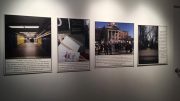Dead Air, the most recent exhibit by Steve Bates, is a mind-bending contemplation on the various aspects of time. Considering not only the officially calculated time signal from various countries but also how our internal body clocks keep track of time, Bates has engineered a thought-provoking exhibit.
The exhibit provides a single headset for a one-on-one exploration of the sounds of silence during a recording; a darkened room filled with a radio, many different clocks and a set of drums, each with a radio inside them broadcasting the official time signal from different countries around the world. There’s a wealth of information in the silence of it all. It’s easy to become lost in your own thoughts while touring the pieces.
So how did Bates take something as abstract as time and put it into a gallery?
It began with an experiment on “real time” of the clocked variety and our own personal sense of the passage of time. Bates taped his friends one at a time in a silent room and had them say, “Start.” They would wait until they thought a minute had passed and say, “Stop.” The shortest minute was thirty-four seconds, the longest, one minute and thirty-seven seconds. Bates then began to play around with the sound between these intervals, which was really no sound at all, just blank space. So what inspired this unusual exploration?
Bates spoke at length about going back to school do to his master’s thesis and how in that time he was inspired by the work of 20th century philosopher Walter Benjamin. One story of Benjamin’s life in particular had a profound effect on Bates and started the cogs turning for the exhibit.
“[Benjamin] was hired by German state radios between World War One and World War Two,” explained Bates. “The radio producer told him there are two things you need to know. One, you have to talk to people as if you’re having a one-on-one conversation, and two, you have to end on the minute or we’ll cut you off. So he became hyper aware of time.”
“About halfway through reading his text, he looked up and the producer had sort of left him on his own, he looked at the clock and it said he had two minutes left. And he went into this total panic because he was only about halfway through his text and he couldn’t figure out what was so wrong with his program that it was so off time. So while he’s still reading his text he starts imagining pages ahead of himself that he can eliminate so that he can end on time.”
“Afterward, Benjamin starts packing up his papers, feeling kind of like a champ that he managed to do this difficult task,” Bates continued. “He thought it was kind of strange that the radio producer hadn’t come back yet, and so he’s gathering up his papers and getting his jacket on and he looks at the clock again and in fact he realizes that the program hasn’t even ended, that this whole last chunk of time has been him broadcasting dead air.”
This story, Bates explained, was the match strike his imagination needed to delve into the lengthy process of piecing together a show. And while Bates may have come to a satisfied conclusion with this gallery, the art leaves the viewer in a contemplative head-space, wondering about the nature of time and how we manage to exist in relation to it.
The Dead Air exhibit opened earlier this month and will run at the aceartinc. (290 McDermot Ave) until Nov. 10.




